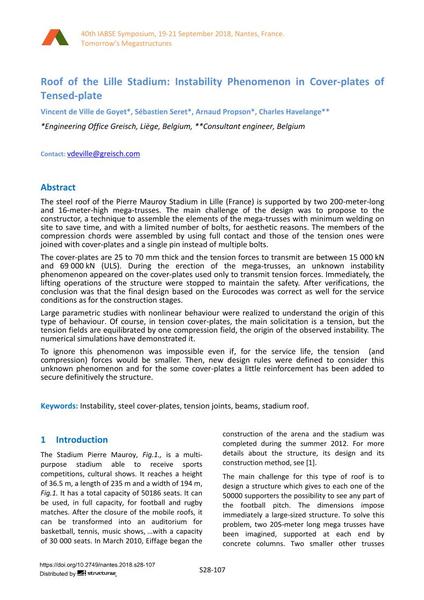Roof of the Lille Stadium: Instability Phenomenon in Cover-plates of Tensed-plate

|
|
|||||||||||
Bibliographic Details
| Author(s): |
Vincent Goyet
(*Engineering Office Greisch, Liège, Belgium, **Consultant engineer, Belgium)
Sébastien Seret (*Engineering Office Greisch, Liège, Belgium, **Consultant engineer, Belgium) Arnaud Propson (*Engineering Office Greisch, Liège, Belgium, **Consultant engineer, Belgium) Charles Havelange (*Engineering Office Greisch, Liège, Belgium, **Consultant engineer, Belgium) |
||||
|---|---|---|---|---|---|
| Medium: | conference paper | ||||
| Language(s): | English | ||||
| Conference: | IABSE Symposium: Tomorrow’s Megastructures, Nantes, France, 19-21 September 2018 | ||||
| Published in: | IABSE Symposium Nantes 2018 | ||||
|
|||||
| Page(s): | S28-107 | ||||
| Total no. of pages: | 8 | ||||
| DOI: | 10.2749/nantes.2018.s28-107 | ||||
| Abstract: |
The steel roof of the Pierre Mauroy Stadium in Lille (France) is supported by two 200-meter-long and 16-meter-high mega-trusses. The main challenge of the design was to propose to the constructor, a technique to assemble the elements of the mega-trusses with minimum welding on site to save time, and with a limited number of bolts, for aesthetic reasons. The members of the compression chords were assembled by using full contact and those of the tension ones were joined with cover-plates and a single pin instead of multiple bolts. The cover-plates are 25 to 70 mm thick and the tension forces to transmit are between 15 000 kN and 69 000 kN (ULS). During the erection of the mega-trusses, an unknown instability phenomenon appeared on the cover-plates used only to transmit tension forces. Immediately, the lifting operations of the structure were stopped to maintain the safety. After verifications, the conclusion was that the final design based on the Eurocodes was correct as well for the service conditions as for the construction stages. Large parametric studies with nonlinear behaviour were realized to understand the origin of this type of behaviour. Of course, in tension cover-plates, the main solicitation is a tension, but the tension fields are equilibrated by one compression field, the origin of the observed instability. The numerical simulations have demonstrated it. To ignore this phenomenon was impossible even if, for the service life, the tension (and compression) forces would be smaller. Then, new design rules were defined to consider this unknown phenomenon and for the some cover-plates a little reinforcement has been added to secure definitively the structure. |
||||
| Keywords: |
beams stadium roof Instability steel cover-plates tension joints
|
||||
